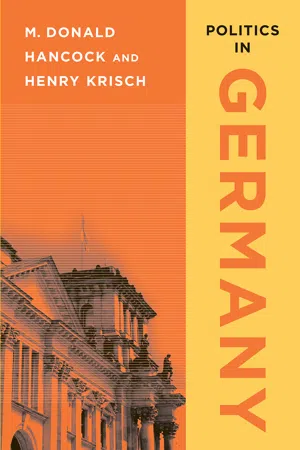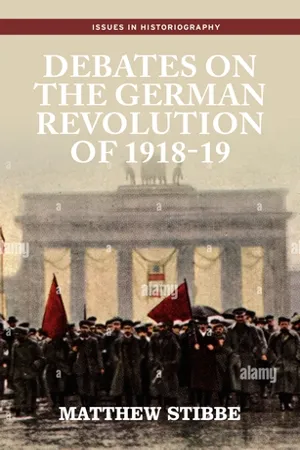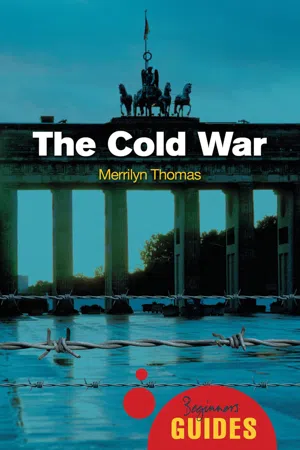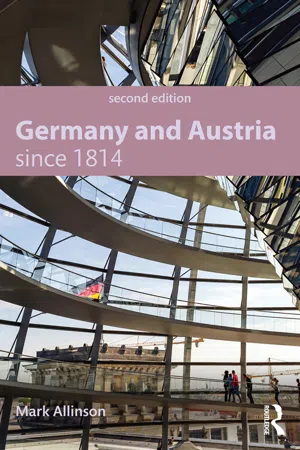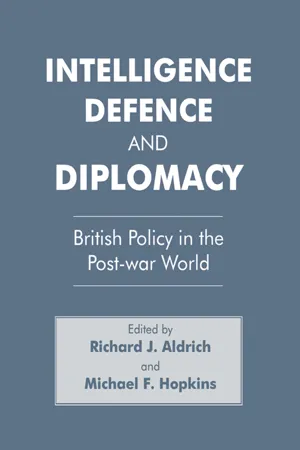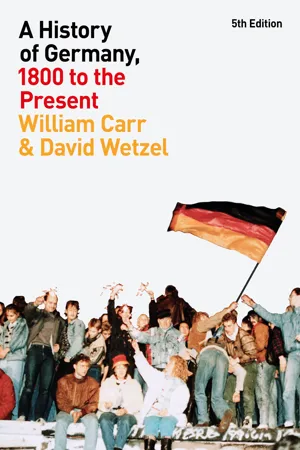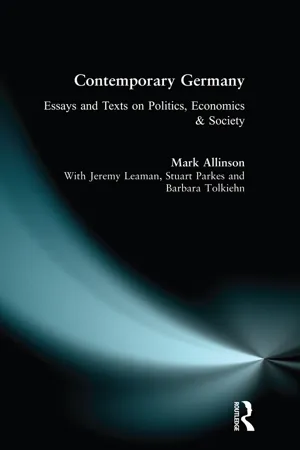History
Division of Germany
The division of Germany refers to the separation of the country into East Germany (German Democratic Republic) and West Germany (Federal Republic of Germany) following World War II. This division was a result of the Allies' decision to split Germany into four occupation zones, with the eastern portion falling under Soviet control and the western portion under the control of the United States, Great Britain, and France.
Written by Perlego with AI-assistance
Related key terms
Related key terms
1 of 4
Related key terms
1 of 3
10 Key excerpts on "Division of Germany"
- eBook - ePub
- M. Donald Hancock, Henry Krisch(Authors)
- 2008(Publication Date)
- CQ Press(Publisher)
3Germany Divided and Unified
G erman politics during the twentieth century was dominated to an unusual extent by history and Germans’ reactions to that history. The half century of Germany’s foreign occupation, division, and unification forms the immediate chronological background to the contemporary scene. For more than forty years, German politics were shaped by powerful external forces of foreign occupation and alliances and by an intense inter-German competition between the two German states created in the war’s aftermath. The end of the Cold War signaled an end to this postwar phase of German history. In the following chapters, we explore the problems and prospects of German politics, domestic and foreign, now and in the near future. Here, we first review the course of German division and the country’s unification.During the Cold War era of German history (1945–1990), three themes dominated politics in both East and West Germany: the future of the German national state, German national identity in its historical context, and the impact on German politics of the international environment. German politics also was animated by contentious domestic social and economic issues. Indeed, the two German states developed starkly contrasting socioeconomic systems. From the perspective of the unified Germany of the twenty-first century, however, with its dominant West German political and economic systems, that economic and social competition is important for the part it played in forming German identity.The Germans dealt with these issues in the framework of two rival states, each linked to a major Cold War bloc. This “cold civil war” on German territory ended with the collapse of the East German state in 1989, the acquiescence of the Soviet Union to German unification within the Western alliance a year later, and the unification of Germany as the Federal Republic of Germany. This proved to be a struggle between two uneven partners. The victorious western Federal Republic was larger, more populous, better endowed with natural resources, and linked to the economically and militarily more powerful ally. Thus the resolution of Germany’s problems in the Cold War historical era has led to a united Germany that must cope with a difficult dual heritage (Nazi and communist), as well as with the task of integrating a poorer, smaller, defeated region into the modern German polity.1 - eBook - ePub
- Matthew Stibbe(Author)
- 2023(Publication Date)
- Manchester University Press(Publisher)
Part II Divided Europe and the politics of history: ‘1918’ in the two GermanysPassage contains an image
3 Revolution betrayed or democracy saved? West German debates, 1949–79The Cold War, which developed apace after 1949, was a truly worldwide phenomenon. Its global reach was underlined by events such as the Korean War of 1950–53, the testing of the first H-bomb in 1952, the Sino-Soviet split from 1960 and the Cuban Missile Crisis of 1962. Nonetheless, it also came to have a special ideological and symbolic significance in central Europe, where two German states – the Federal Republic founded in May 1949 and its Communist rival, the German Democratic Republic, established in October of the same year – stood on what for much of the 1950s and the early 1960s seemed to be the brink of all-out war. From 1955 they were also integrated into rival military alliances – the American-led NATO in the case of the FRG and the Warsaw Pact in the case of the GDR.Just as the German nation was split in half after 1949, so too was the German history profession. However, the timeline for this did not follow the course of the Cold War exactly. In the early 1950s there were still some on both sides who hoped that there was enough common understanding to allow for the maintenance of a single professional body for German historians. The final split came in the mid-to-late 1950s. West Germans such as the conservative Gerhard Ritter, President of the Verband der Historiker Deutschlands (German Historians’ Association (VHD)), refused to accept the new East German journal the Zeitschrift für Geschichtswissenschaft, founded in 1953, as a ‘scientific’ publication, denouncing it as Marxist propaganda. Very few western historians would write for it. Then, at its annual conference in Trier in September 1958, the VHD forbade three East German historians – Ernst Engelberg, Max Steinmetz and Leo Stern – to speak if they appeared as official representatives of the Deutsche Historiker Gesellschaft (German Historians’ Society (DHG)), the new East German body that had been founded a few months before. The DHG ordered a full-scale walk-out, and henceforth instructed all of its members to resign from the VHD.1 Finally, in the run-up to the eleventh International Congress of Historical Sciences in Stockholm in August 1960, Ritter successfully pressed the Swedish organisers not to allow an official delegation from the GDR to attend, insisting that there was only one legitimate body for German historians – the VHD.2 - eBook - ePub
The Cold War
A Beginner's Guide
- Merrilyn Thomas(Author)
- 2012(Publication Date)
- Oneworld Publications(Publisher)
It had already been decided at Yalta that for practical purposes Germany would be divided into zones to be administered by the victors. But the stated intention was that this was a temporary measure. It had been agreed that in the foreseeable future Germany would be reunited. Within four years, however, Germany had been transformed into two separate states, West Germany and the GDR. The Division of Germany symbolised the division of the world and the conflict which became the Cold War. Whose fault was it that an iron curtain was created across Europe? Which side was to blame: the Russians or the Americans?The Allies were falling out almost before the ink was dry on the Potsdam agreement. In October 1945, the first meeting of foreign ministers in London set up to provide a forum for discussion on Germany broke down. Although later the West claimed that the Division of Germany had been forced upon it by Stalin, research now suggests that essentially the Division of Germany was more favoured by the USA and Britain than the Soviet Union. Western talk of a unified Germany was merely a ‘figleaf’.2 A British government top secret report confessed some years later that: ‘Though we cannot admit it publicly, both sides would gain by avoiding the reunification of Germany.’3 Stalin might have accepted a neutral demilitarised Germany. What he would not accept was a Germany drawn into the economic and military alliance of the West. But a strong anti-communist West Germany rapidly became a Western priority with the aim being to shift the blame for the division. In 1946, a British diplomat was quoted as saying that ‘we have to make the Russians appear to the German public as the saboteurs of German unity’.4The speed with which Europe was divided is remarkable. By March 1946, less than a year after Potsdam, Churchill was in the USA making his famous speech in which he declared that:From Stettin in the Baltic to Trieste in the Adriatic an iron curtain has descended across the Continent. Behind that line lie all the capitals of the ancient states of Central and Eastern Europe. Warsaw, Berlin, Prague, Vienna, Budapest, Belgrade, Bucharest and Sofia, all these famous cities and the populations around them lie in what I must call the Soviet sphere, and all are subject in one form or another, not only to Soviet influence but to a very high and, in some cases, increasing measure of control from Moscow.5 - eBook - ePub
- Mark Allinson(Author)
- 2014(Publication Date)
- Routledge(Publisher)
Bundesrepublik) and claiming that the western allies’ decision to negotiate Germany’s future without the Soviet Union represented a breach of the 1945 Potsdam Agreement. The west, meanwhile, blamed the Soviet authorities and the SED for pursuing their political agenda in an undemocratic fashion which made agreement impossible, forcing unilateral progress. The Berlin Blockade and the SED’s intimidation of the elected Berlin city council in 1948 are taken as evidence of this.Certainly there was intransigence on all sides. Each of the wartime allies recognised the crucial importance of Germany to Europe’s future development, and each wished to make a decisive contribution to the shape of the future state. However, the incompatible aspirations of the Soviet Union and the western powers fractured Germany along the borders between the separate occupation zones. For the French in particular, Germany’s division was in any case desirable, as it weakened a state which had invaded France on three occasions (1870, 1914 and 1940) in the previous eighty years. Churchill also initially took this view, arriving at the Potsdam Conference with maps showing different scenarios for dividing Germany into two or more separate states.Debate continues particularly about the Soviet Union’s policy objectives for postwar Germany, with suggestions that Stalin had always intended to turn the Soviet occupation zone into a communist puppet state. Despite greater access to Soviet archival records, the debate remains somewhat speculative. It certainly seems likely that Stalin wished to extend Soviet influence across Germany, but improbable that he would have provoked conflict with the western powers – particularly so soon after the highly costly Second World War – by attempting a communist takeover of the entire country. But the transformation of just the Soviet zone into a separate communist state was not in Stalin’s interests either. The Soviet zone seemed unviable as an independent state, as it was poor in natural resources and had an underdeveloped infrastructure; furthermore, the Division of Germany impeded the Soviet Union’s access to the reparations it had been promised from the western zones. Finally, the inclusion of the strong West German state in the west’s anti-Soviet defensive alliance, the North Atlantic Treaty Organisation (NATO), was the worst possible outcome for the Soviet Union as it tried to rebuild and consolidate after the Second World War. The USSR’s attempts during the 1950s to overcome Germany’s division by offering to sacrifice the GDR (seep. 159) testify to this. - eBook - ePub
A History of Germany 1918 - 2020
The Divided Nation
- Mary Fulbrook(Author)
- 2021(Publication Date)
- Wiley-Blackwell(Publisher)
It is clear that there was a considerable divergence in cultural life in the two Germanies, although they had certain themes to contend with in common. This is particularly the case with questions such as the confrontation with the Nazi past, and with the more general issue of building new national identities and political cultures in two very different parts of a divided nation. It is to these broader questions that we now turn.The Divided Nation: National Identities and Historical Consciousness in the Two Germanies
The German Democratic Republic and the Federal Republic of Germany, formally founded in 1949 as Cold War images of their respective occupying powers, faced several key problems in the attempts to develop new national identities. There was that of being a partial state, a severed limb of a defeated and divided nation, with a political regime in the main imposed by the will of the occupying powers and not representing an indigenous development from the people. There was that of coping with the horrific legacy of the Third Reich, where racist doctrines had led to the bureaucratically organized mass murder of over six million Jews and of others deemed ‘unfit to live’. There was that, finally, of attempting to impose drastically new forms of regime – communism and liberal democracy – on populations lacking, by and large, appropriate political values and attitudes. It should be remembered that, whatever their rather wayward actual effects, the denazification and re-education programmes of both the Western and Eastern occupying powers did not succeed in producing a majority of convinced democrats or communists, respectively. (If anything, they succeeded in creating a certain sense of national community where Hitler had failed: a so-called ‘community of sympathy’, or Sympathiegemeinschaft, of aggrieved Germans carping and grumbling about the injustices being meted out to them by the occupation authorities.) It has frequently been said that the Weimer Republic failed in part because it was a ‘Republic without Republicans’. If there was any truth in that analysis, then the prospects for the two Germanies could hardly be said to have been much better: in the West, a democracy with precious few democrats in the immediate postwar era; in the East, a communist state with a minority of communists. Over time, it can be argued that political culture in the two Germanies became more appropriate to the divergent political forms – even if it was not entirely what the earlier occupying powers or the later respective German governments would necessarily have desired. There were shifts and changes in official interpretations of national identity; there were changing historiographical fashions and evaluations of the place of the present in relation to the past; and there were also some notable transformations of popular political culture in each state, arguably arising less from official attempts to build new national identities than from other features of the sociopolitical environment.8 - eBook - ePub
A History Shared and Divided
East and West Germany since the 1970s
- Frank Bösch(Author)
- 2018(Publication Date)
- Berghahn Books(Publisher)
Third, as a result of the intense rivalry between East and West Germany and the mutual insistence on drawing lines of demarcation, the two states were more closely tied to one another than to other neighboring countries. On the one hand, they were permanently engaged in refuting practices and concepts coming from the other side of the Wall; on the other hand, this rivalry spurred on domestic improvements in each state, be it in terms of social policy or education, sports, or dealing with the Nazi past.Last, given the shared history of Germany since reunification in 1990, it also makes sense to look at the decades beforehand from a shared perspective, not with a focus on 1989, but rather with an eye to the difficulties involved in growing together as one Germany. Such an approach allows for a better understanding of why there are still significant differences between East and West even today. Both Germanys are the divided past of our unified German present.It must be kept in mind, however, that many things were different in East and West, even if they shared the same name. A political party or trade union in the West was fundamentally different from a political party or trade union in the East. Likewise, the search for transfers and entanglements bears the risk of overinterpreting the relevance of individual contacts, interactions, or mutual observations—a danger that is inherent to transnational history in general. Moreover, the creation of a new teleological master narrative leading up to 1989 has to be avoided.62 Not only do historians need to explain the downfall of the GDR, but also they have to account for its long-lasting stability, which made even West German experts think that reunification was not on the horizon in early 1989. And, finally, it cannot be assumed too rashly that a sense of national unity or a shared German identity in both states justifies a joint perspective in and of itself. Even within the GDR, a feeling of “we” evolved that did not necessarily correspond to the “socialist nation.”63 Too little attention has been paid up to now on how the concept of the “nation” developed within the context of divided Germany and how stronger supranational identities were built before and after unification.64 - eBook - ePub
Intelligence, Defence and Diplomacy
British Policy in the Post-War World
- Richard J. Aldrich, Michael F. Hopkins(Authors)
- 2013(Publication Date)
- Routledge(Publisher)
3 Reunification or Integration with the West? Britain and the Federal Republic of Germany in the early 1950s Klaus LarresDOI: 10.4324/9781315035925-3The period between the fall of the Berlin Wall in November 1989 and the merging of East and West Germany on 3 October 1990 was marked by worries and the concern of many people that a unification of the two Germanies would destabilize Europe.1 It was alleged that a united Germany with a population of almost 80 million would soon become a new economic superpower and once again an arrogant political giant on the international scene.2 Only very few people believed that the four victorious powers of the Second World War were genuine and unequivocal supporters of the creation of a unified German state. However, developments in Eastern Europe in 1989–90 seemed to make German unification inevitable. Britain, France, the United States and the Soviet Union now had to stand by their many promises to the German people during the previous 45 years and convert these pledges into reality.In the 1950s, when the international scene was still very fluid and the modus vivendi of the Cold War not yet fully accepted, politicians in East and West also kept professing that they were seriously interested in overcoming the partition of Germany as soon as possible.3 Why, then, did it never materialize? After all, politicians and the military in the early 1950s genuinely believed that a permanent Division of Germany would soon lead to turmoil and war. Based on the convictions as expressed at the Potsdam Conference in 1945, they thought that only a united Germany would guarantee a peaceful and economically healthy Europe. Otherwise it was assumed the German people would soon create so much trouble in order to obtain unity and prosperity that the stability of Europe and the world would be seriously endangered.4 This attitude began to change with the gradual Western realization that not only Chancellor Adenauer but above all the West German people, the huge majority of the German population, were not really very much interested in getting the country reunified. Despite the popularity of the unification issue in opinion polls and ‘the simmering discontent with the Division of Germany’,5 the West Germans were apparently much more concerned with rebuilding their own careers and enjoying the fruits of the burgeoning economic miracle than with the fate of their brethren in the East. The High Commissioner in Bonn even claimed that the Germans were mainly interested in the ‘three Bs’ – belly, BMW and building society account.6 - eBook - ePub
Brief summary of the complete frame of the German Question (1945-1990)
From a historical and legal standpoint
- Johann Albert Wiechers(Author)
- 2020(Publication Date)
- Difundia Ediciones(Publisher)
One of the most terrible human problems of this intra-German border resulted from the closing for more than four decades of a zone which had once been fully economically integrated, located in the heart of Germany. Until 1945 this region was in the center of Germany and of Europe, and consequently was perfectly inter-communicated. The division, and especially the building of a closed border line, destroyed the naturalHinterlandof local industry and agriculture, and turned this zone into the frontier of two enemy systems, where the Cold War was fought, and might have become the first battleground in an eventual Third World War. Consequently, it became impoverished and depopulated on both sides of the wires, and started receiving subsidies from both German governments. But the fall of the «Wall» -comprising this term also the «intra-German border»- in 1989, plus both the economic and political reunifications in 1990, permitted this area to recover its condition as geographical center of Germany, a free transit region within an every-day more communicated and integrated Europe. - eBook - ePub
- William Carr, David Wetzel(Authors)
- 2023(Publication Date)
- Bloomsbury Academic(Publisher)
15 A Nation Divided1945: A Shattered CountryIn the summer of 1945 Germany was utterly devastated. Great cities had been reduced to heaps of smoking rubble, communications were totally disrupted, and the administrative apparatus shattered. The German people were dazed and bewildered by the ordeal of total war. Over three million German soldiers had been killed in action, one million were prisoners of war in Russia, many never to return, and half a million civilians had been killed in air raids. Heim ins Reich , the proud Nazi slogan of the 1930s, took on a new meaning as millions of panic-stricken refugees streamed westward before the advancing Red Army.Before the fighting ended, the “Big Three”—Roosevelt, Stalin, and Churchill, meeting at Yalta in February 1945—set the seal of approval on arrangements for the occupation of Germany, which were dictated in large measure by the nutcracker strategy they had pursued. Temporarily Germany would be divided into four occupation zones: the Russians in the east, the British in the northwest, the Americans in the southwest, and the French in a small zone in the west carved out of the British and American zones. Authority would be vested in an Allied Control Council consisting of the four commanders in chief meeting in Berlin. That city, to be occupied by the four powers, would remain the German capital. Germany would be demilitarized, denazified, and obliged to pay reparations, not in money—the error of the 1920s—but in kind. While no formal figure was agreed on, 50 percent of the reparations would be given to Russia in recognition of the immense devastation caused by German aggression.With their armies firmly in control of Germany, the Big Three met at Potsdam in July 1945. By this time the Americans had abandoned the Morgenthau Plan to pastoralize Germany and divide it into several small states. German unity was preserved although for the time being a central authority would not be reestablished. But political recovery would be encouraged along democratic lines in all zones. A more immediate task was denazification which the occupying powers undertook enthusiastically—indeed, this turned out to be the only subject on which complete agreement could be reached. The most spectacular example of four-power unity was the Nuremberg Trial of major war criminals in 1945–6, when leading Nazis and their advisers were tried and in nearly all cases found guilty of conspiracy to commit wars of aggression and crimes against humanity. The reparations arrangements were shrouded in some ambiguity. Each power was to dismantle industrial plants in its own zone and take goods from current production. At the same time the German economy was to be treated as a whole and the German people permitted a standard of living no higher than that of neighboring peoples. To coordinate economic activity in the zones five central administrative offices staffed by Germans would be set up. Already deeply uneasy about Russian actions, President Harry S. Truman and Clement Attlee, the newly elected British prime minister, promised Russia only 25 percent of reparations deliveries from their zones. Finally—and with great reluctance—they accepted a major territorial change in Germany’s eastern frontiers ahead of a peace treaty: de facto Polish administration of former German territory up to the line of the Oder and Neisse Rivers and the partition of East Prussia between Russia and Poland. - eBook - ePub
Contemporary Germany
Essays and Texts on Politics, Economics & Society
- Mark Allinson, Jeremy Leaman, Stuart Parkes, Barbara Tolkiehn(Authors)
- 2014(Publication Date)
- Routledge(Publisher)
The GDR simply ceased to be, its only formal legacy the provisions of the unification treaty which the FRG pledged to respect. These included a number of amendments to the Basic Law, principally the removal of Article 23, thus confirming that the expanded FRG had no further territorial aspirations to any ‘other parts of Germany’. The western structures established after the war were simply extended to the new Länder of the east, a territory cynically described by some dissatisfied east Germans as the ’Beitrittsgebief ; to some the swallowing whole of the GDR by the Federal Republic appeared reminiscent of the Anschluss of Austria to Hitler’s Germany in 1938. Even before the GDR disappeared, most of its political parties had merged with their western counterparts, the DBD farmers’ party and the National Democratic Party arranging takeovers by the western CDU and FDP respectively. Only the PDS was left as a significant, specifically east German force. The GDR citizens’ protest movements like Neues Forum and Bündnis go, which had provided the framework for the Wende, were too small to exert much influence over the east’s political development. The first Bundestag elections in united Germany brought a clear majority for the CDU/CSU-FDP coalition led by Helmut Kohl, who reaped his reward as the ‘unity Chancellor’. German unification rescued Kohl: barely a year earlier he had appeared a tired leader, unable to solve West Germany’s economic problems and ripe for replacement at the next elections; the CDU had fallen behind in the opinion polls. With the fillip of German unification, the CDU now scored even more highly in the west than in the east. The SPD, meanwhile, found that its vote in the east lagged some twelve per cent behind that in the west, reflecting both the party’s continuing lack of organisational infrastructure in the new states, and the proportion of left wing voters, almost ten per cent, who preferred the PDS
Index pages curate the most relevant extracts from our library of academic textbooks. They’ve been created using an in-house natural language model (NLM), each adding context and meaning to key research topics.
Explore more topic indexes
Explore more topic indexes
1 of 6
Explore more topic indexes
1 of 4
